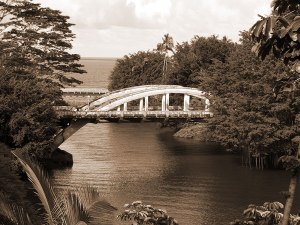 In Hawaii, the lifestyle is relaxed and changes come slowly. And yet things do change. The days of the sugar cane plantations are long gone. Yet, the people, the built structures and the memories remain.
In Hawaii, the lifestyle is relaxed and changes come slowly. And yet things do change. The days of the sugar cane plantations are long gone. Yet, the people, the built structures and the memories remain.
Hawaii was greatly affected by the era of the sugar cane plantations, from the land, the buildings, to the people that live there. During the 1850’s to 1950’s, the sugar cane plantations were an important source of income for Hawaii and dominated the social structure. Between the years 1857 and 1994, there were approximately 22 different plantations operating on the Big Island alone. At the industry’s peak in 1931, Hawaii’s sugar plantations employed more than 50,000 workers and produced more than 1 million tons of sugar a year.
It was the need for cheap labor that brought hundreds of thousands of immigrants from Japan, China, Korea, Philippines, Puerto Rico, and Portugal. Hawaii’s food, customs, music and dialect all stem from this mix of ethnic groups. Surrounding the plantations were the workers “neighborhoods” separated by ethnic group. The lives of these immigrants were immersed in the plantation. They bought their food and supplies at the plantation store, went to plantation churches and children went to plantation schools.
As each ethnic group came to Hawaii, they brought with them their traditions and culture. For example, Buddhist temples could be found in the Japanese section of almost every plantation along with their own resident Buddhist priest. Because the workers spoke different languages, they struggled to find a way to communicate with each other. The language that emerged from this struggle is called “Hawaiian Pidgin”, a hybrid influenced from Hawaiian, English, Japanese, Chinese and Portuguese. You can still hear this dialect spoken today.
In 1994, the Hamakua Sugar Company brought in its final harvest and left over 400 families without work. The Hamakua Coast has since made a slow recovery, as the closure of the Sugar Cane companies opened up tens of thousands of acres of prime agricultural land, which came replete with an extensive irrigation system and a network of well-maintained cane-haul roads. Learn more here: www.hawaiibusiness.com/the-coast-is-clear/